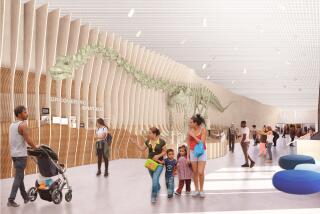Weekend Paleontologists Just Love Getting Down and Dirty
- Share via
DENVER — Rita Ervin was a mom at home for more than 30 years before she started excavating dinosaur fossils, using pickaxes and paint brushes.
“I wasn’t sure I could do this,” she said. “Little did I know I’d be unearthing bones and studying with professionals, and loving every minute of it.”
Ervin, 53, from nearby Aurora, recently completed the amateur paleontologist program at the Denver Museum of Nature and Science. The program offers hands-on training at fossil excavation sites and classes that include research methods, report writing, geology and vertebrate paleontology.
Richard Stucky created the program in 1990, and has seen teenagers, brain surgeons, bankers and retirees come through. Most continue to search for fossils on their own and go on digs years after they graduate.
“The best part about the program is you don’t need any experience,” Stucky said. “In fact, many of the students didn’t know a thing about paleontology. They just have loved dinosaurs since they were kids.”
The two-year program is run mostly by museum staff. Tuition costs as little as $700 depending on classes, which are taught in the evenings.
Students are required to take field trips, camping out at digs in Utah, the Dakotas, Wyoming and Colorado. They even help scout for fossils and collect data.
Volunteers must work in a laboratory located within the Prehistoric Journey exhibit. They use dental picks, air scribes and paint brushes to free fossils from their plaster and rock casings. The fossils are then pieced together for the exhibit.
Bob Rushforth, a 57-year-old chemical engineer, graduated four years ago and continues to volunteer at the lab and go on digs.
“I work at a computer all day in an office. Then I come here and I have a chance to use my hands, and it’s refreshing,” he said as he cleaned a fossil from the Triassic period.
Children and parents lined the glass windows of the lab asking questions about the fossils Rushforth and volunteer Sue Meyer were cleaning.
“I am learning all the time,” Meyer said while touching up a fossil from an Ankylosaurus, an 18- to 22-foot plant-eater with a club-like tail. “And I get to impart a little dinosaur knowledge on others. It’s a great job.”
About 160 amateurs have graduated. Some go back to college for advanced degrees in paleontology and geology, and many have published papers in scientific journals.
Former student Carol Weiskof even had a new species of a giraffe-like dinosaur named after her. She helped dig up a Cedarosaurus Weiskopfae skeleton at Arches National Park in eastern Utah.
Graduate Bruce Young has found at least five sites that have yielded bones. Most recently, he found the body armor of an Ankylosaurus on the property of a computer company in suburban Broomfield. He also discovered the tooth of an unidentified carnivorous dinosaur.
Students studied the geology of each site to create the exhibit. Some of their findings are on display at the museum. Exhibit walls and rooms are set up as different prehistoric periods, and aim to explain the science behind the birth and extinction of plant and animal species before human evolution.
The rooms are crammed with dinosaur skeletons, many of them pieced together with real bones found by museum volunteers.
“I love this place,” said 9-year-old Rachel Seiff of Grand Junction. “I studied dinosaurs last year in school and it’s so interesting to see what they look like in real life.”
More to Read
Sign up for Essential California
The most important California stories and recommendations in your inbox every morning.
You may occasionally receive promotional content from the Los Angeles Times.













